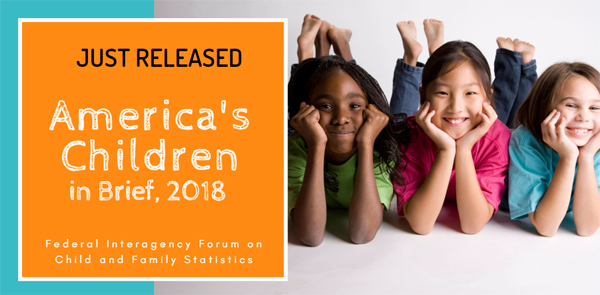New release features latest statistics from U.S. government agencies on the status of at-risk children and youth

The latest annual report of federal statistics on the health and well-being of America’s children and youth is now available. The 2018 America’s Children in Brief: Key National Indicators of Well-Being, highlights six measures on the status of children and youth who face heightened risks to their well-being. The report is published by the Federal Interagency Forum on Child and Family Statistics, a collection of 23 federal government agencies involved in research and activities related to children and families, including the Eunice Kennedy Shriver National Institute of Child Health and Human Development, part of the National Institutes of Health.
Highlights from this year’s report which feature six measures on the status of at-risk children and youth include:
- Poverty and extreme poverty: In 2016, 18 percent of all children ages 0–17 were living in poverty (that is, in families with incomes below 100 percent of the poverty threshold), down from 22 percent in 2010. The percentage of children living in families in extreme poverty (below 50 percent of the poverty threshold) was 8 percent in 2016, down from 10 percent in 2010.
- Health insurance continuity: The percentage of children chronically uninsured declined from 5 percent in 2005 to 2006 to 2 percent in 2015 to 2016.
- Homelessness: In the 2015 to 16 school year, 1.4 million students, or about 3 percent of students in U.S. public elementary and secondary schools, were reported as homeless children or youth.
- Exposure to violence: In 2014, more than one-third of all children experienced a physical assault, and 5 percent had been sexually victimized.
- Prescription opioid misuse and use disorders: Among youth ages 12 to 17 in 2016, 0.9 million (3.5 percent) had misused prescription opioids in the past year.
- Residential placement of juveniles: The overall residential placement rate, which calculates the number of juvenile offenders placed in detention centers and other facilities, fell from 356 per 100,000 juveniles in 1997 to 152 per 100,000 in 2015.
This year’s report also includes updated statistics on children and families in the United States across 41 report indicators, covering a range of domains: family and social environment, economic circumstances, health care, physical environment and safety, behavior, education, and health. The full report is posted on www.childstats.gov. Single hard copies are available free from:
Government Printing Office
8660 Cherry Lane
Laurel, MD 20707
laurelwms@gpo.gov

 BACK TO TOP
BACK TO TOP